All across Europe, you will find limitless amounts of well worked out attacking structures. However, only the most productive and efficient allow their teams to compete for the top honours on the biggest stage.
In this tactical analysis, we will take a look at three of the best attacking structures in the women’s game. In all three, we can see certain similarities that bring success, but also specific dynamics of each team that allow them to be truly special. From Barcelona’s focus on wingers to Lyon’s marauding full-backs to Wolfsburg’s unique inside forwards, each of these sides possess specific tactics and structures that result in them dominating their domestic leagues and challenging on the European stage.
Barcelona Femini
The first team we will look into is Barcelona. The Catalonian club are storming to their first league title in four years, having lost out to Atletico Madrid in the previous three. Summer signing Jennifer Hermoso from their rivals has brought an extra attacking dynamic that has seen them net 86 goals in only 21 matches played. Put into context, second-place Atletico Madrid have scored 43 in their 21 matches. In this analysis, we will detail how the side goes about obtaining such an impressive goal-scoring record.
Barcelona are extremely aggressive in their set-up. In the next two sections, we will detail how each side look to keep at four players back in their structure in the event of a counter-attack. Barcelona, however, much more commonly leave three back when getting forward in attack. Hamraoui sits in front of the two centre-halves, and Cules allows the full-backs the freedom to push forward to join the wingers in attack. At times, one of the two more advanced midfielders will drop in line with Hamraoui, but this is more often than not in the initial stages of possession to progress the build-up when the side is struggling.
Barcelona’s attacking principles are based on the general idea of manipulating an opponent’s defensive structure to one side of the pitch before looking for a quick transition to the opposite side to take advantage of space. Most often, this will include overloads on the initial side to force the opposition’s defensive shape to move over to cover the numbers. Once this is achieved, one or two passes, either in the air or through the midfield, are used to get possession to the winger or full-back on the other side. It is then up to these players to use their abilities to take advantage of the space.
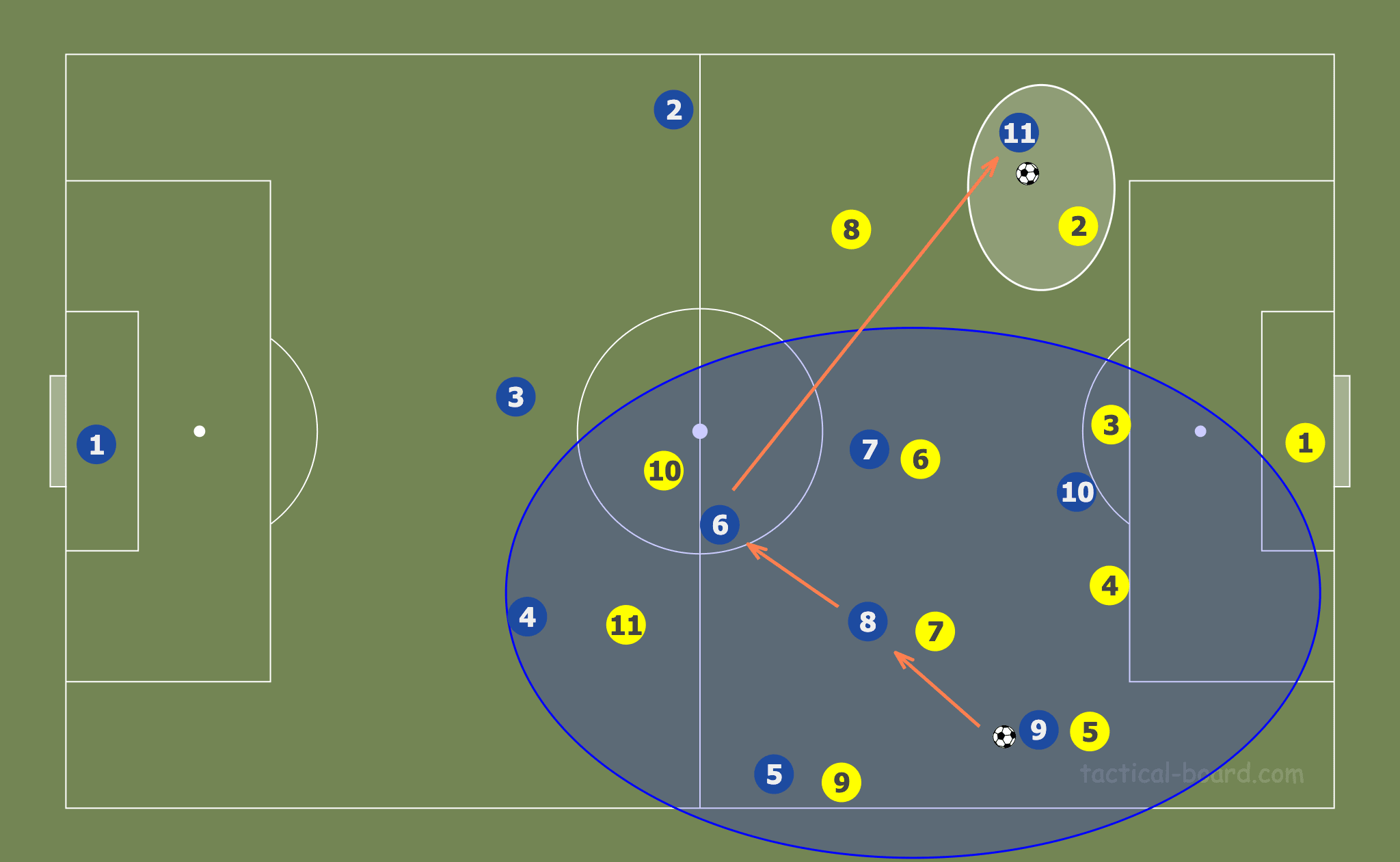
Most of the time, the two eight’s sit in between the attacking line and Hamraoui. They are essential in Barcelona’s most frequent attacking patterns. Ahead of them, the full-backs push forward to combine with the wingers in hopes to overload the opponent’s full-backs.
So much of Barcelona’s play goes through their pivot. Hamraoui most often occupies this role, and her abilities allow her, and the side as a whole, to excel. She is one of the best in the world at evading press and opening space and opportunity for her teammates. The first option Barcelona look for is to move possession through Hamraoui into one of the two number eights just ahead of her. Here, the central midfielders try and create space for their teammates out wide. When possession is picked up, they run into the half-space. With the presence of the striker occupying the centre-half, it forces the full-back to make a decision on how to defend the situation. If they stay in a wider area, the central midfielder will make a run into the half-space and exploit the gap between the defenders before looking to get a shot or cross in. However, if the full-back tucks in, a pass will be made quickly into the winger. This forces the full-back to try and quickly get back into position, but the Barcelona winger has the advantage in what typically is a 1v1 scenario. If they cannot get around the defender themselves, the full-back will look to overlap and provide a passing option, and the striker and midfielders will look for space as well to offer support.
The Barcelona wingers have some of the best numbers in the world when it comes to attacking space with and without the ball. Caroline Hansen averages 11.49 dribbles per 90, completing 69.9% of them. Lieke Martens averages an astounding 12.67 dribbles per 90, and averages 62.8% of them. These two are Barcelona’s primary options out wide, and these statistics are examples of why this is. In addition, Hansen averages 6.99 progressive runs per 90, while her counterpart averages 6.13 per 90.
When the wingers are able to beat their full-backs to look to get in a cross, they will often look to cut it back to the top of the box. Here the two number eight’s look to sit and find room for these type of opportunities. The speed at which Barcelona enter the final third forces defenders and midfielders to drop in very quickly, which gives the intelligent Catalonian players the opportunity to slip a marker and find space as the defence worries about the player in possession moving towards goal.
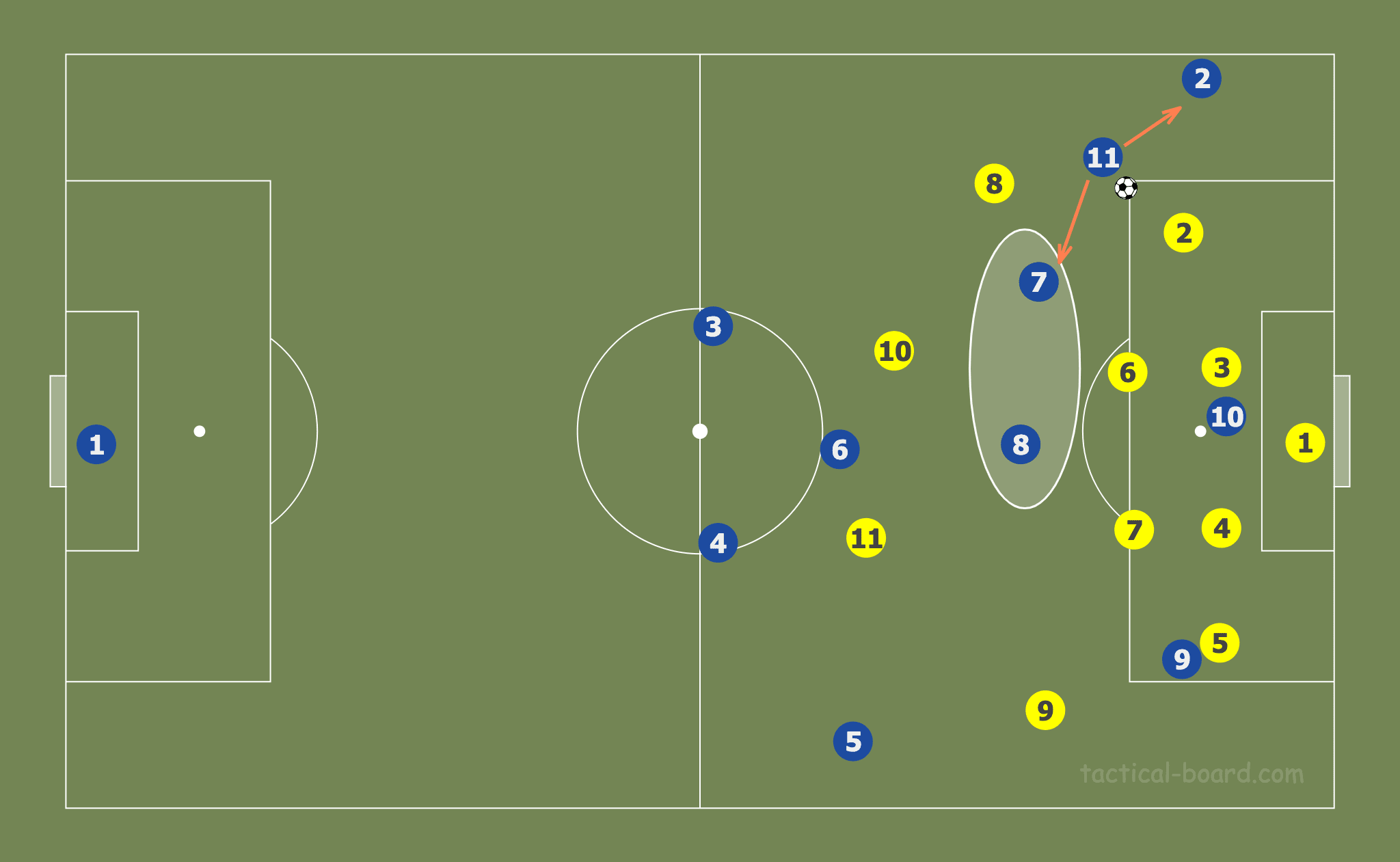
Because of this idea, something we began to see in the last few games was Jennifer Hermoso being deployed in one of the eight roles. Here she offered multiple advantages for Barcelona. Having her occupy these areas at the edge of the box for cut back opportunities is a very potent threat. She also offers diversity in attack and pressing. While she plays in the midfield, she is able to move forward and join the striker to create overloads should the chance present itself.
Wolfsburg
Wolfsburg are widely known for their attacking dominance in the German top flight. This productivity that sees them averaging an astounding 4.625 goals per match in their domestic league comes from a very unique structure they implement when looking to break sides down. In this analysis, we will outline this structure and look at the specific avenues they look for in possession.
When Wolfsburg work through their build-up phase, they set up to pin their opponents deep in the final third. They do so by setting up a forward line of six. One central midfielder and one full-back push forward to join in this attacking line. The central midfielder acts as a secondary striker on the opposite side of Harder, who typically plays off the right side of the main striker. The other midfielder, typically Gunnarsdottir, drops deep right in front of the defensive line and acts as the orchestrator for the attack. In terms of the full-backs, we normally see one of the two get forward into the attack, while the other drops in to form a back three with the centre-halves. This structure in defence allows them to remain compact in the event of possession being lost and the opponent looking to counter. Below you can see an image of this shape in Wolfsburg’s match.
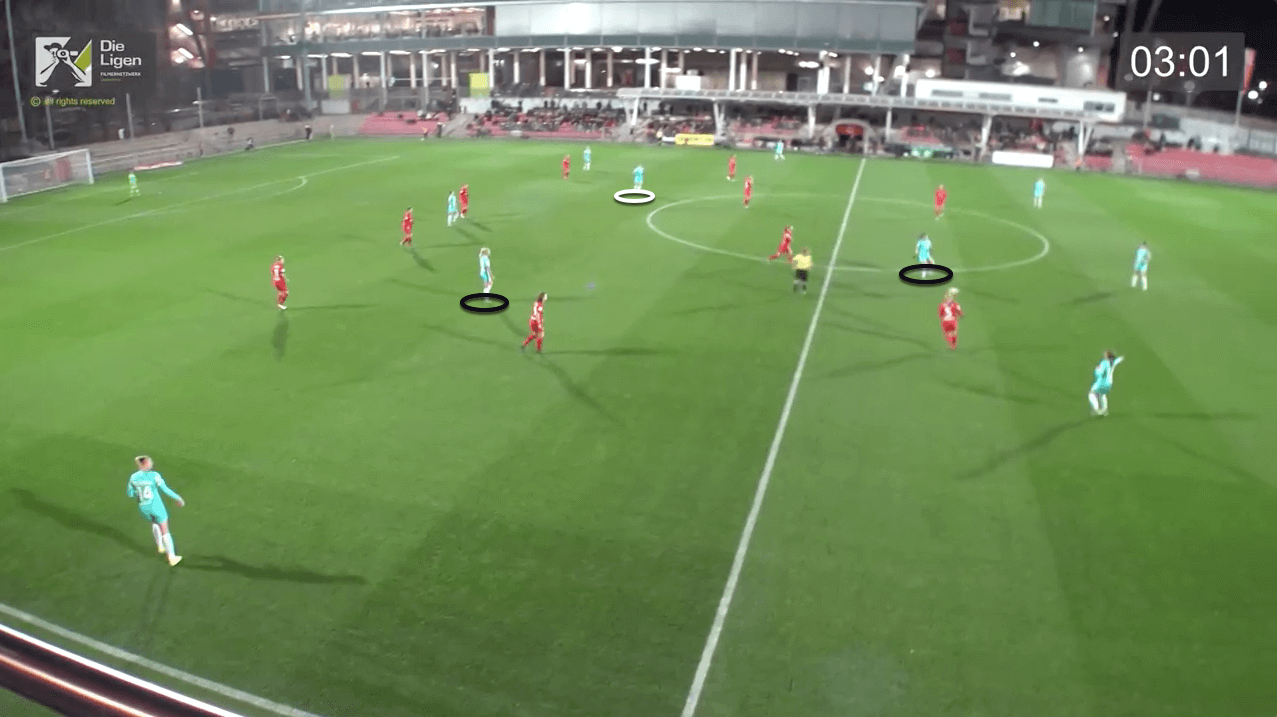
Now, when they are in this shape, Wolfsburg look for specific avenues to generate chances to find space behind the opponent’s defensive block. The first is through the use of the inside forwards. Here, Popp and Harder are at their most effective. The two look to position themselves in pockets of space between the midfield and defensive lines. Both players are extremely intelligent and use this to draw out their markers in these positions to open up space for teammates.
As they move into these areas, Gunnarsdottir or one of the defenders will look for passing lanes in between the midfield press to find them. If the inside forward has found a big enough gap, they will look to turn and dribble at the defence. This is where they can be at their most dangerous.
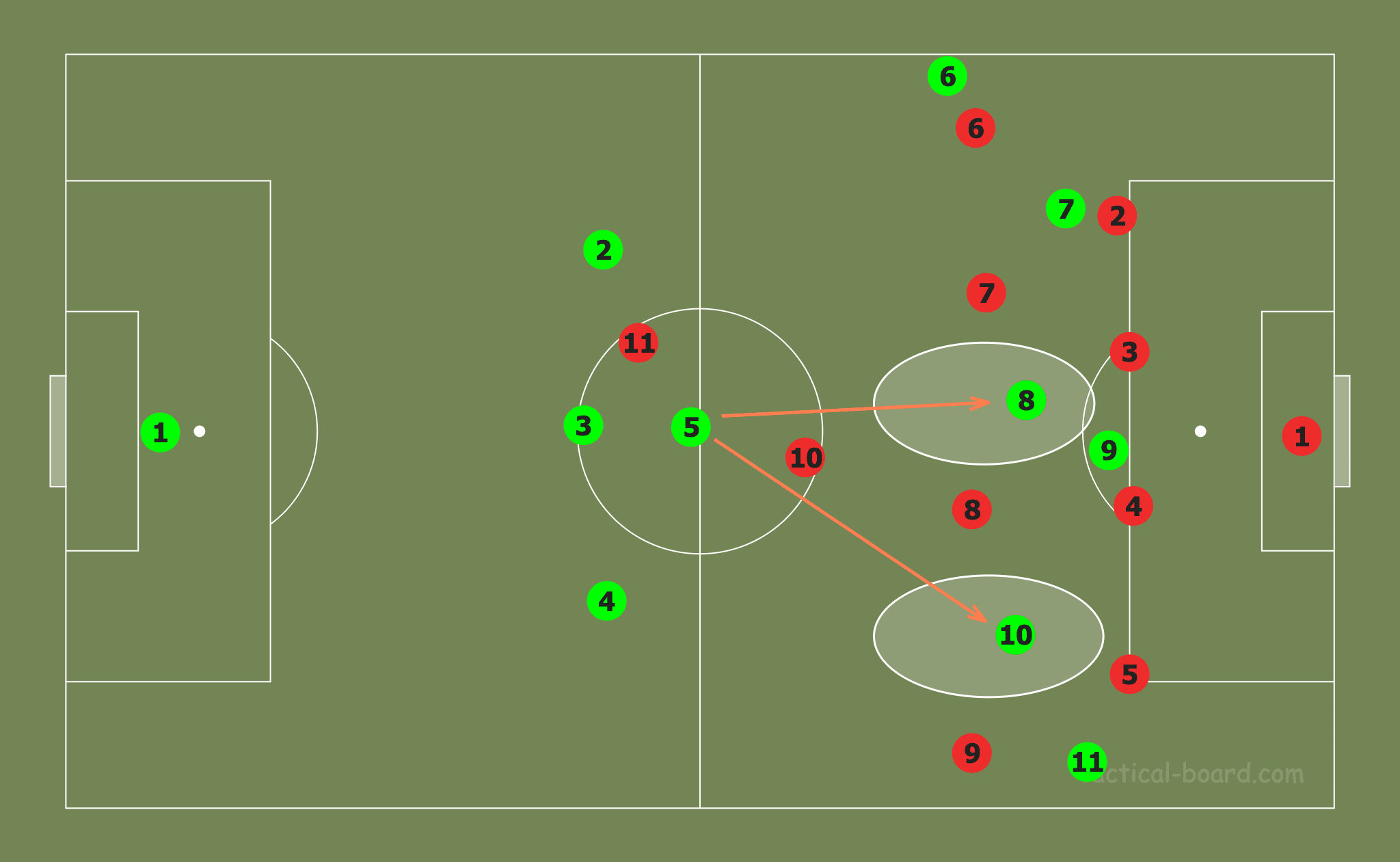
When possession reaches the position you see above, defences have serious difficulties containing Wolfsburg’s attack. Here, the inside forward can have up to three or even four passing options to either side of them along with taking it forward themselves. This amount of forward players allows Wolfsburg to create overloads with the purpose of releasing one player unmarked in behind.
The inside forwards in Wolfsburg’s system are the most essential part of their game and provide an incredible amount of productivity. Harder averages an unbelievable 1.67 goals per 90 to go along with 0.33 assists. On the other side of Pajor as her, Popp averages 0.69 goals per 90 and 0.43 assists. Together they are combining for slightly over three goal contributions per 90 minutes.
Additionally, if these passing options are not available, the focus will switch to the wings. Here, the inside forwards are essential as well as they provide the ability to overload these channels. Here, the defending full-back has the freedom to move forward to try and progress play forward should it be needed. If this is successful, the opposite full-back will drop in to provide cover. This gives Wolfsburg three players between the channel and half-space to look to combine.
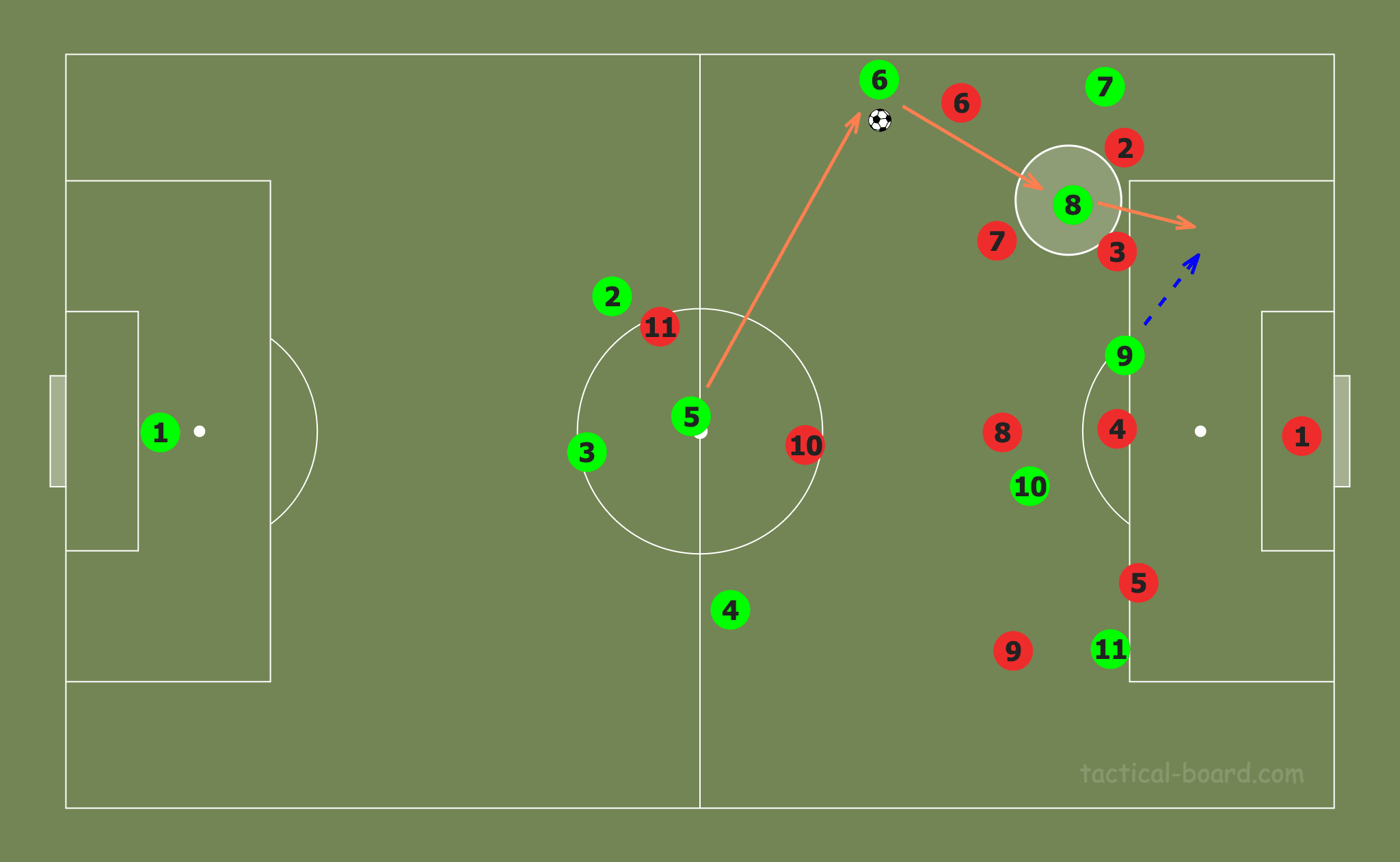
The wide midfielder and inside-forward both tend to occupy positions right against the defensive line. This forces the defenders to stick to them. This creates the opportunity for Pajor to take advantage of space in behind. The opposite inside forward comes more central to create a 2v1 with the centre-half marking the number nine and forces her to make a decision on who to mark. Often times Pajor is able to peel off of this defender and make a run off the back shoulder of the central defender on the ball side. Below you can see an example of this.
Olympique Lyonnais
Well known for their dominance in not only France but in European competitions, Lyon are one of the most dynamic attack sides in the world. Led by their star striker Ada Hegerberg, who is unfortunately sidelined currently with an ACL injury, the French side have won the UEFA Women’s Champions League four seasons running, and before the halt of the season looked in good shape to make it a fifth in succession. Here, we will take a look at the dynamism that allows Lyon to be so efficient in front of goal.
Different to the Wolfsburg set up we previously discussed, Lyon use a different build-up structure. When possession is gained, they continue to use their double pivot system. This allows the full-backs, Lucy Bronze and Alex Greenwood typically, to be able to get forward and join the attack as they please. These full-backs are responsible for a large amount of the attacking potency Lyon possess. The width that these two provide to the side allow the attacking players to move into central positions and look for space to exploit opponents.
Lyon’s double pivot is essential in everything that they look to do. It is here that attacks are most often generated. Both Henry and Kumagai possess incredible passing ranges that allow them to find teammates all across the pitch. During the 2019/20 season, Henry has averaged 20.65 forward passes per 90, which is a third of her 60 passes per 90. She completes these at a 77.5% rate. Her partner Kumagai averages just over 17 forward passes per 90, which is just under a third of her 64 passes per 90. She averages a 76.1% completion rate on these. These statistics emphasise the ability these two players have in moving the ball forward in attack.
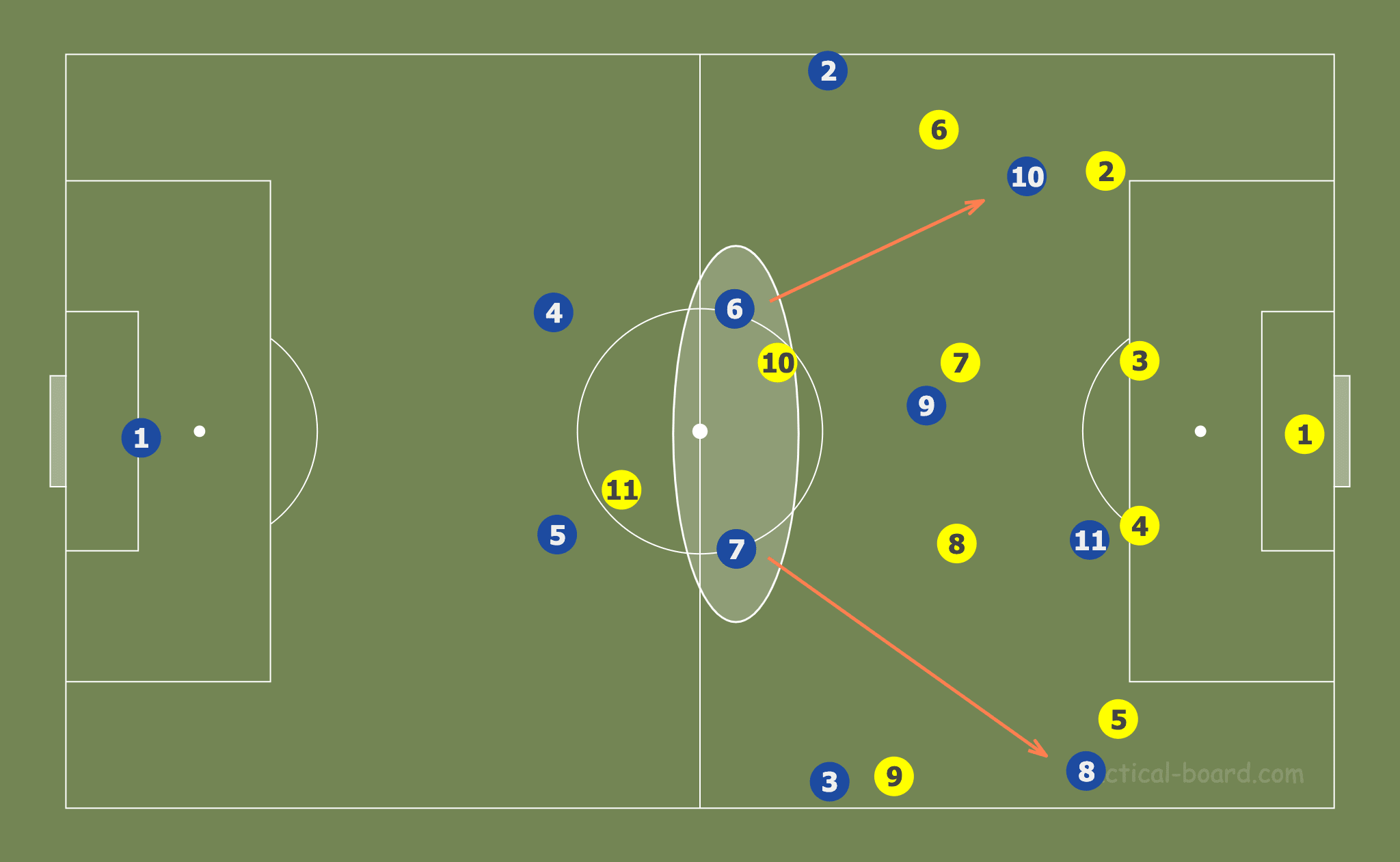
A common outlet we see from these passes is to the wingers. Every player that plays in this position for Lyon is extremely adept at running forward with the ball at their feet. The side use these talented players to the best of their advantage. As we spoke on with Barcelona in their wide outlets, this can be seen with Lyon a lot of the time. Normally it will be one of the two holding midfielders that will find the wingers in isolated positions after possession has moved around to shift the opponent’s defensive block.
When possession reaches these areas, Lyon’s next phase of attack begins. From here they seem to have two main options. Hegerberg is one of the best strikers in the world, and will often move into the half-spaces to try and create room for a run in behind or look to link up with the player in possession. The second central attacker, most often Dzsenifer Marozsán, is given the most freedom out of the whole side. Depending on the opponent’s structure, she will either play on the final line of defence alongside Hegerberg or drop deep to help link possession and provide another midfield option. The main outlet is the full-backs like we mentioned above, though. As soon as the wingers receive possession, the full-backs push up the field extremely quickly and provide an overlap or underlap option depending on how the winger approaches the opponent.
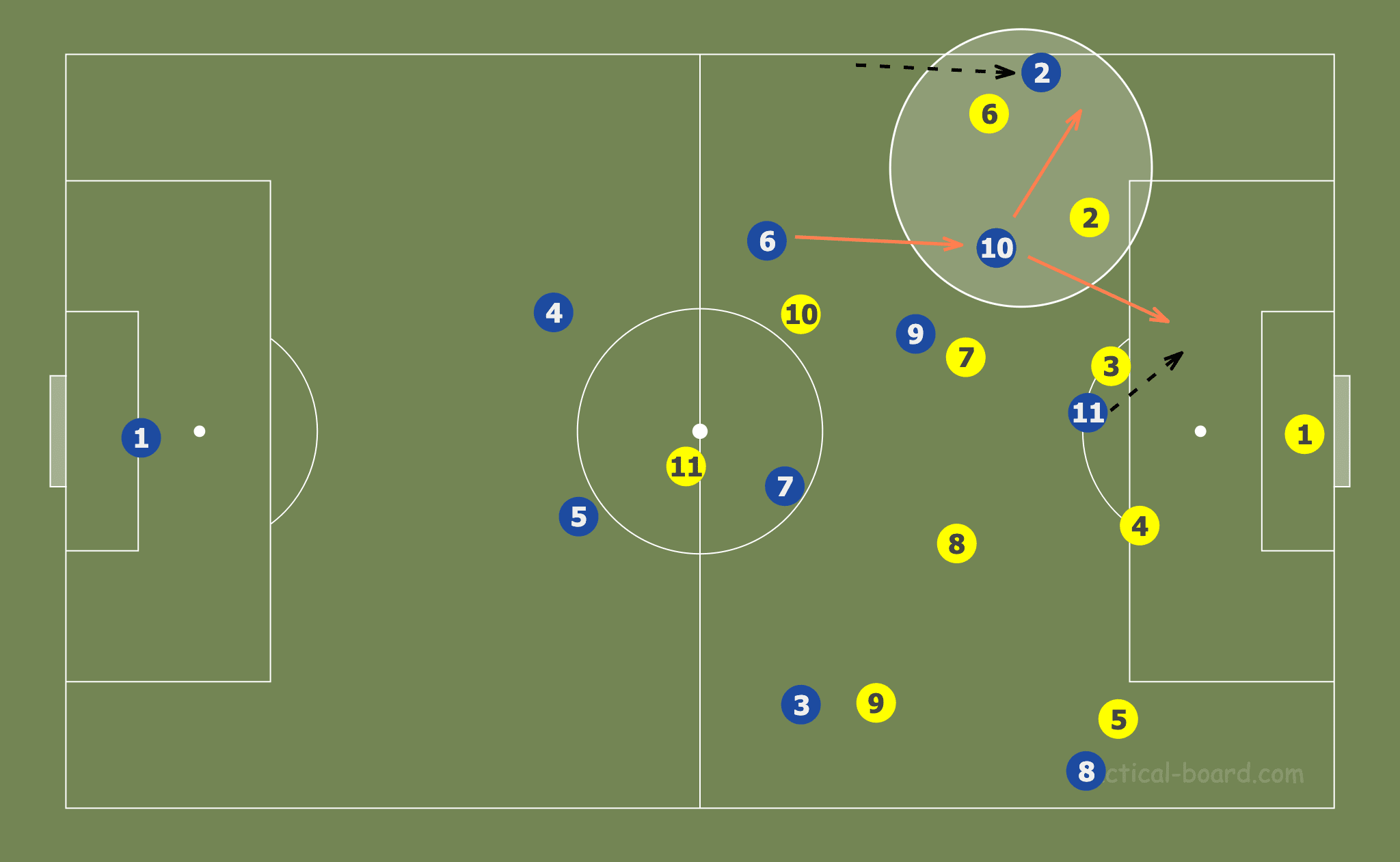
Amel Majri is also essential for Lyon’s attack on the left-hand side. Her wide ability has been utilised in the half-spaces for the French side most often. The major benefits of this tactic is to allow her to move inside and combine with the central players and also giving the left-back room out wide to press forward into the attack. Above you can see this structure as possession is being worked on the left side.
Conclusion
When looking into these sides, it is easy to see the attacking talent that allows them to be successful. However, even these quality players require an effective structure to play in to be at their best. In each of the sides we have looked at in this analysis, this is evident.
Each side possesses its own specific attacking structures and movements that allow them to create opportunities. While some of these tactics require very specific players with specialised talents, parts can be taken from each of them as clubs across the world aim to find a successful formula such as these.






Comments